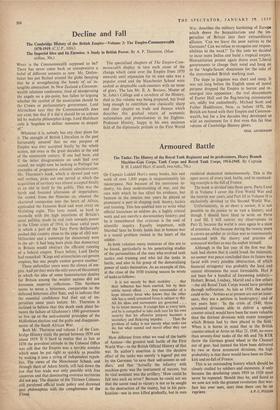Armoured Battle
The Tanks: The History of the Royal Tank Regiment and its predecessors, Heavy Branch Machine-Gun Corps, Tank Corps and Royal Tank Corps, 1914-1945. By Captain B. H. Liddell Hart. (Cassell, two vols., 70s.) OF Captain Liddell Hart's many books, this vast work of over 1,000 pages is unquestionably his masterpiece. Not because of his enormous in- dustry, his deep understanding of war, and the care with which he has sifted his evidence, but because in the interim war years he played so prominent a part in shaping tank theory, tactics and training. This has enabled him to write what official historians so seldom do, a highly critical work and not merely a documentary history; and be it remembered that criticism is the soul of scientific inquiry. Equally important, with Marshal Saxe he firmly holds that at bottom war is a moral problem rooted in the heart of the soldier.
In both volumes many instances of this are to be found, particularly in his penetrating studies of the personalities of the men who evolved tank tactics and training and who led the tanks in battle, and also in his grasp of the demoralising power of tanks themselves. As an example of this, at the close of the 1930 training season he wrote of tanks as follows : It is not merely by their mobility . . . that their influence has been exerted, but by their subtle moral effect. . . . Any commander of a large infantry force who knows that the other side has a small armoured force is subject to this. All his ideas and movements are governed . . . by its latent menace. It cramps him at every turn, and he is compelled to take such care for his own security that his offensive purpose becomes a secondary and flickering impulse. . . . Thus the problem of today is not merely what tanks can do, but what mental and moral effect they can have.
How different from what we read of the battle of Amiens—the greatest tank battle of the First World War—in the British Official History of that war. Its author's assertion is that the decisive effect of the tanks was merely 'a legend' put out by the Germans `to save their self-esteem as sol- diers,' and that 'Actually the infantry with machine-guns was the instrument of success, but its vital assistant was the artillery.' How could he fall into such an error? Because he could not see that the surest road to victory is not to be sought in the destruction of the enemy, but in his para- lysation—not in men killed gradually, but in men rendered demented instantaneously. This is the open secret of every tank battle, and its outstand- ing example is the fall of France.
The book is divided into three parts. Parts 'I and II in Volume I cover the First World War and the interim war years, and Part Ill in Volume II is exclusively devoted to the Second World War.
Unfortunately, in so short a review, it is not possible to do justice to so vast a history, and though I should have liked to write on Parts I and III, I will restrict my observations to Part II, because the world is once again in a state of armistice. Also because during the twenty years it covers no soldier or civilian was so continuously connected with the theory and practice of armoured warfare as was the author himself.
Although in the last year of the first war the tank had shown that it could break the stalemate, no sooner was peace concluded than its future was faced with every possible obstruction, of which financial stringency was probably the least and mental obtuseness the most formidable. Had it not been for a handful of foreseeing soldiers— Hobart, Broad, Lindsay, Martel and a few others —the old Royal. Tank Corps would have perished through suffocation. As late as 1930, the author could write : 'Armies as at present are not an insur- ance, they are a petition in bankruptcy,' and of ten years later : 'In the crisis of 1940, three armoured divisions able to deliver a speedy counter-attack would have been far more valuable than the thirteen divisions with motor transport which Britain had by then placed in the field.' When it is borne in mind that in the British counter-attack at Arras on May 21, 1940, no more than seventy-four tanks of the 4th and 7th RTR threw the German grand wheel to the Channel out of gear, had instead the blow been delivered by two or three armoured divisions, the high probability is that there would have been no Dun- kirk and no fall of France.
This is an outstanding history which should be closely studied by soldiers and statesmen, if only because the desolating years 1919 to 1939 must never be repeated. Should they be, and faced as we now are with the greatest revolution that war- fare has ever seen, next time there can be no










































 Previous page
Previous page